If you’re like me and you’re watching in horror as trout streams across America take one body blow after another thanks to the ongoing heatwave (and in some parts of the country, record drought), you’re wondering if trout fishing will ever be the same. You may even be considering throwing in the towel for the foreseeable future. In some areas, where low water levels, record high temperatures and warming waters are proving perilous to coldwater fish, it may be a while before hitting the river with a clear conscience is even an option. But the heat doesn’t have to put you on the fly fishing sidelines just yet. Across trout country, lakes and reservoirs offer some great fly fishing for trout, especially for those anglers willing to learn a new long-rod discipline that’s long been employed by fly fishers in possession of float tubes and flippers.
Yes, the fishing can be significantly different in deep water, but with just a few shifts in gear and strategy, you can chase trout through the drought and still enjoy summer. And there’s a bonus: many reservoirs and lakes across the country are stocked with trout for the sheer and sole purpose of angler harvest — if you like to eat trout, these are the fish you should be chasing.
Here’s what you need to know to get started chasing stillwater trout, and some basic gear you might need to update, especially if it’s been a while since you pulled the old float tube out of storage.
Often, it’s not about your cast
Chasing trout in deep water where temperatures are colder and food is more plentiful is often a depth thing, not a “how far do I need to cast?” thing. In fact, with heavy shooting heads or full-sinking fly lines (which you’d opt for being dependent on the depth of the lake or reservoir you might be fishing), your cast may be the last thing you need to worry about, especially if you’re fishing from a float tube or a kayak. Instead, if you’re streamer fishing, success or failure is typically determined by the retrieve speed and the action you give the fly while it’s in the feeding zone—which might be several dozens of feet below the surface. Certainly, if you can “chuck and duck” and throw 40-feet of sinking line without giving yourself a Slump Buster earring, go for it. But for most of us, it’s just as easy to let a few feet of line out as we kick backward with our flippers or drop the rod in the rod holder and make a few paddle strokes until the line stretches tight. Trolling, you say? You’re darn right, and any long-time float-tube angler would scoff at the notion that trolling is somehow cheating.
Of course, in those instances when trout are feeding on top on lakes or reservoir (usually early and late in the day when air temperatures cool off the top few feet of the water body and insects are hatching), you can fall back on your more general outfit and cast dry flies with floating lines while matching the hatch. But—I’d reckon about 80 percent of the time—if you become serious about fishing lakes and reservoirs, you’ll be stripping (or trolling) in hopes of getting into fish.
Borrow from the gear folks
In some lakes where prolific hatches do occur, it pays to be a float-tube nympher, and you can go about using smaller flies to imitate larval insects a number of ways. First, just like streamer fishing, you can slowly and methodically retrieve nymphs using sinking lines and lead-core leaders. Or, you can use your more traditional floating line, add 15 feet or more to your leader and borrow a strategy from your local bait fishers. Just drop a nymph 10-12 feet below a strike indicator. But, remember, aquatic insects that “hatch” at the surface move up through the water column. An occasional rod lift coupled with a back paddle or a kick will lift the nymph up a bit — this is when I usually get most of my strikes using this method.
The idea is to get the fly down into the zone and then try and draw attention to it. And yes, you’ll spend time watching a “bobber,” but the method works, even if you catch some grief from fellow anglers who might consider it a very small step above dropping a worm into the drink.
Float tubes, pontoons, kayaks
Depending on the craft you choose to use, your angling strategy will likely change significantly. If you’re fishing from a float tube (either wet or adorned in chest waders) you’ll be using your feet more to kick and steer. If you’re sitting a bit higher in a pontoon boat, you might be using the oars now and then. When I fish from a pontoon, I still hang my feet in the water — my flippers are my go-to locomotion method. I tend to use the oars only when I’m trying to move a little quicker and get to a certain place on the lake.
If you’re a kayak angler in deeper water, you face a number of challenges, but you also enjoy some advantages. First, and most importantly, if you’re at all versed in paddling a sit-on-top kayak or some of the newer, technologically superior fishing kayaks, you’re going to stay dry. You’ll also enjoy more space for storage and, if you have the peripherals to complete your angling ensemble, you’ll have holders for extra rods and maybe even a cooler to store some cold beer (or drop a harvested trout on ice). Some fishing kayaks come equipped with pedal-powered fins or propellers — a real advantage in deeper water — to help you move about the lake or reservoir with relative ease. The disadvantage with kayaks in deeper water? If you’re not equipped with pedal-power, you will spend time paddling. It’s not an “if” proposition — it will happen, and you’ll need to be able to use the paddle proficiently enough to help you troll streamer patterns and combat wind and any subtle currents that might be present in the lake.
I enjoy fly fishing from kayaks, but I tend to use these crafts more in shallow water where I can paddle to numerous destinations and then take advantage of the option to get out and wade now and then. I love fishing kayaks inshore for saltwater fish like redfish and speckled trout, or in shallow freshwater bays for carp. For trout in deeper water, I find that the disadvantages outweigh the conveniences.
Rods, reels and lines
Generally speaking, for lake and reservoir trout, a typical 9-foot, 5-weight fly rod will suffice. Consider, though, that you’ll likely be fishing with heavier, sink-tip or full-sink lines, and larger streamers. As a result, I like to fish a 6 or 7-weight rod for stillwater trout, largely because of the lines I use and the size of the flies I retrieve.
As for lines, it completely depends on the depth of the lake or reservoir you plan to fish and how deep you need to get. For deeper stillwater destinations, I almost always start with a full-sink line, the like the RIO Mainstream Type 6 sinking line. It sinks six inches per second and, while RIO maintains that it’s “castable,” I wouldn’t spend too much time trying, particularly if you’re low in the water in a tube. For shallow lakes or lakes with obvious structure, like underwater wood, rocks or drop-offs, you might be better with an intermediate sinking fly line or a sink-tip fly line. My go-to sink-tip line for lakes with drop-offs and nearshore structure is the RIO In-touch StreamerTip line. It’s got a short 10-foot sinking tip, which actually does make it eminently castable. This is the line you should use when you’re targeting obvious structure, or casting back toward shore and retrieving flies over structure or drop-offs.
For nymphers, any old floating line will work, but you’ll want to use fluorocarbon leader and tippet or, if you need a quick sink, lead-core leader. Consider heavier nymphs, too, tied sparsely with tungsten beads—this will give them a quick “up and down” action when you lift the rod tip periodically.
Final word
No, fly fishing in lakes isn’t for everyone, and that’s completely alright. For many fly fishers, the idea of watching an indicator or trolling in a float tube isn’t very appealing. But, with summer bearing down on us and a relentless drought dropping water levels and raising water temperatures in our favorite trout rivers and streams, learning the intricacies of fly fishing lakes and reservoirs could save your trout season.
And, as I said, the guilt-free harvest of a few trout that grow big and fat in the plentiful lake environment is an added bonus. Enjoying a wild-caught trout cooked on the grill is a tough-to-beat summertime treat.





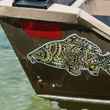





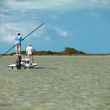
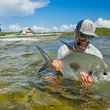


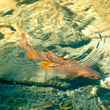




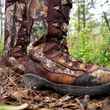




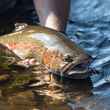
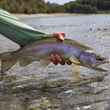


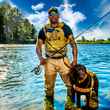
Comments
Craig M Vohwinkle replied on Permalink
If you are contending with surface temps of 70° or higher in rivers, dosesnt the same hold true for stillwaters? And if so, is not trout mortality just as possible while landing the fish and pulling them up through the warmer surface waters? I have only started fishing stillwaters recently, and I have opted to chase warm water species rather than risk potentially increased trout mortality during the early and mid-summer periods here in Northern Michigan.
Pages